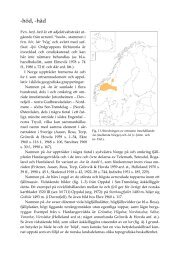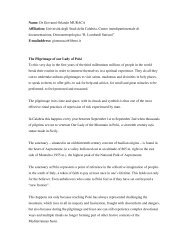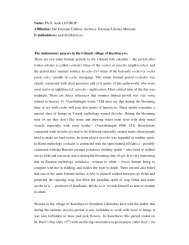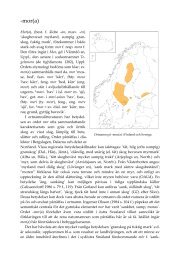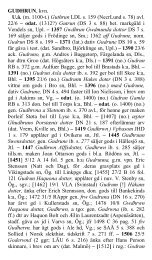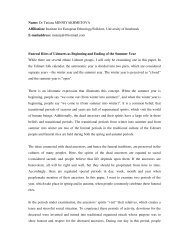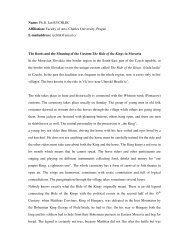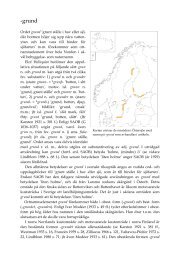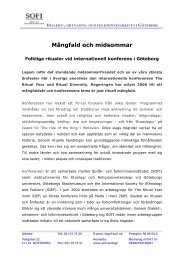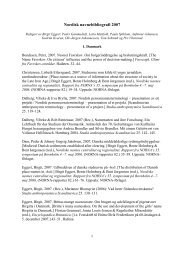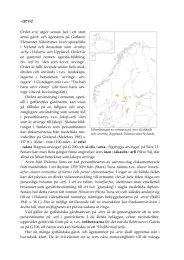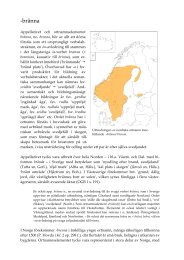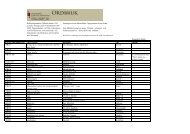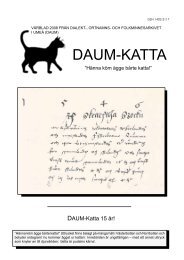NORNA-RAPPORTER 88 Binamn. Uppkomst, bildning, terminologi ...
NORNA-RAPPORTER 88 Binamn. Uppkomst, bildning, terminologi ...
NORNA-RAPPORTER 88 Binamn. Uppkomst, bildning, terminologi ...
Create successful ePaper yourself
Turn your PDF publications into a flip-book with our unique Google optimized e-Paper software.
<strong>Binamn</strong> i Norden 21<br />
Stockholms stads jordebok 1420–1474. 1876. Stockholm. (De svenska stadsböckerna<br />
från äldre tid. Ser. 1. Stadsböcker 1.)<br />
Sundström, Agneta, 2004: Mæster Sigga hustrv, hustrv Birgitta Midakers och hustrv<br />
Elin i Sæby. Olika sätt att benämna kvinnor i Arboga stads tänkebok. I: Namn (se<br />
detta). S. 127–132.<br />
— 2008: Panka, Sokkofot, Hynda och Kunta. Användning av binamn i Arboga med<br />
rättsligt efterspel. I: Namn från land och stad. Hyllningsskrift till Mats Wahlberg 25<br />
maj 2008. Uppsala. (Namn och samhälle 21). S. 175–180.<br />
Svahn, Margareta, 1999: Den liderliga kvinnan och den omanlige mannen. Skällsord,<br />
stereotyper och könskonstruktioner. Stockholm.<br />
Wahlberg, Mats, 1999: Uppsalaborgare på 1600-talet. I: Runor och namn (se detta). S.<br />
105–116.<br />
Wetås, Åse, 2008: Kasusbortfallet i mellomnorsk. Ein komparativ studie av proprialt og<br />
appellativisk materiale. Oslo. (Doktoravhandlinger forsvart ved Det humanistiske<br />
fakultet, Universitetet i Oslo 360.)<br />
Williams, Henrik, 1993: Ō-namn. Nordiska personnamn med det privativa prefixet Ō-.<br />
I: Personnamn i nordiska och andra germanska fornspråk (se detta). S. 95–107.<br />
Zilliacus, Kurt, 1966: Ortnamnen i Houtskär. En översikt av namnförrådets sammansättning.<br />
Helsingfors. (Skrifter utg. av Svenska litteratursällskapet i Finland 416.<br />
Studier i nordisk filologi 55.)<br />
Summary<br />
Bynames in Scandinavia<br />
An outline<br />
By Eva Brylla<br />
The aim of this paper is to give an outline of personal name research in Scandinavia.<br />
Earlier research was mostly etymological in approach. Among other things, the study of<br />
bynames has been able to provide evidence of words that are otherwise rarely documented.<br />
The mid 1970s saw an expansion of modern Scandinavian personal name research.<br />
One question that remains unresolved is the demarcation of the category of bynames.<br />
Like other names, bynames are the subject of certain syntactic claims. One such claim<br />
is that a byname should be able to occur independently, for example be used together<br />
with or instead of an official name.<br />
There is, however, a third type of byname that does not meet this requirement of independence,<br />
e.g. Lange in Lange Sven ‘tall Sven’ or Robinson in Robinson-Emma (referring<br />
to the person’s connection with a reality television series). Such elements are not<br />
proper names, but rather are classified as byname elements.<br />
If we focus on the function of bynames, the independence claim can become complicated.<br />
Attributes like (Kristin) Skræders ‘tailor’s (wife)’ and (Olaus) Gydhakulle<br />
‘Gydha’s husband’ are generally included among bynames, even though they do not<br />
satisfy the requirement of independence.<br />
Different types of bynames that are defined either as bynames or alternatively as appellatives<br />
are discussed, e.g. patro-/metronymics and occupational and local designations.<br />
Although <strong>terminologi</strong>cal issues have been discussed a great deal at different Scandinavian<br />
conferences and in the onomastic literature, there is still much uncertainty and<br />
fluctuation. Most controversial are the terms binamn ‘bynames’ and tillnamn ‘surnames’.



